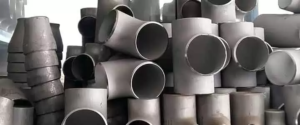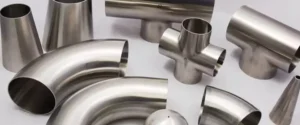How Do Duplex Steel 2205 Pipe Fittings Compare to Stainless Steel Pipe Fittings?

Choosing the right material for pipe fittings is essential for industries dealing with harsh environments, high pressures, or corrosive chemicals. Among the top choices are Duplex Steel 2205 pipe fittings and stainless steel pipe fittings. Both materials offer excellent properties, but their performance, durability, and cost can differ significantly based on the application.
In this blog, we will explore how Duplex Steel 2205 pipe fittings compare to stainless steel pipe fittings, helping you make a more informed decision for your specific needs.
What Is Duplex Steel 2205?

Duplex Steel 2205 is a high-performance alloy that combines the best qualities of austenitic and ferritic stainless steel. With approximately 22% chromium, 5% nickel, and 3% molybdenum, it provides excellent corrosion resistance and strength.
It is primarily used in industries with critical strength and corrosion resistance, including oil and gas, chemical processing, marine applications, and desalination plants.
What Is Stainless Steel?

Stainless steel is widely used for its corrosion resistance, durability, and affordability. There are several grades of stainless steel, but 304 and 316 are the most commonly used for pipe fittings.
304 stainless steel is ideal for general-purpose applications, while 316 stainless steel contains molybdenum, offering enhanced corrosion resistance in more demanding environments.
Strength and Durability: Duplex 2205 vs. Stainless Steel
Regarding strength, Duplex Steel 2205 outperforms standard stainless steel grades like 304 and 316. Its yield strength is twice that of austenitic stainless steel, making it the preferred material for applications requiring high mechanical strength.
While durable, stainless steel pipe fittings don’t match the mechanical strength of Duplex 2205. They are still widely used in applications where extreme stress isn’t a concern, but for high-pressure systems or heavy-load environments, Duplex 2205 is a better choice.
Corrosion Resistance: A Key Difference
One of the most significant differences between these materials is their corrosion resistance. Duplex Steel 2205 offers far superior protection against pitting, crevice corrosion, and stress corrosion cracking, especially in chloride-rich environments such as marine or chemical plants.
While 316 stainless steel provides decent corrosion resistance due to its molybdenum content, it still cannot match the anti-corrosive capabilities of Duplex Steel 2205 in highly aggressive conditions. In contrast, 304 stainless steel is more susceptible to corrosion, particularly in environments with high levels of salt or chemicals.
Duplex Steel 2205 will offer better performance, longevity, and reduced maintenance if your project involves long-term exposure to corrosive substances.
Temperature Resistance and Thermal Stability
Another critical comparison point is temperature resistance. Duplex Steel 2205 performs well in low and moderate temperatures, retaining its toughness and strength in extreme conditions. It is especially suitable for applications involving cryogenic temperatures or temperature fluctuations.
On the other hand, stainless steel pipe fittings like 316 also offer good heat resistance. Still, Duplex 2205 is more resistant to thermal expansion and thus performs better in environments with constant high temperatures and pressure changes.
Cost Comparison: Is Duplex 2205 Worth the Investment?
One of the most commonly asked questions is about the cost difference between these two materials. Duplex Steel 2205 pipe fittings are generally more expensive than stainless steel fittings. This is mainly due to its production process’s complexity and specialized properties.
However, Duplex 2205’s higher initial cost is often offset by its longer lifespan and lower maintenance requirements. In industries where corrosion and mechanical failure could lead to costly shutdowns or replacements, Duplex Steel 2205 is a cost-effective option in the long run.
If your application doesn’t require the superior strength or corrosion resistance of Duplex 2205, opting for stainless steel fittings could be a more budget-friendly solution.
Welding and Fabrication
Welding Duplex Steel 2205 requires more skill and precision compared to stainless steel. The heat-affected zones in Duplex 2205 can become brittle if not properly handled. Therefore, the welding process for Duplex Steel 2205 must follow stricter guidelines to preserve its corrosion resistance and mechanical properties.
In contrast, stainless steel fittings like 304 and 316 are easier to weld and fabricate, making them more suitable for industries where welding is frequent and the fitting process needs to be simpler.
Applications: Where Each Material Shines
Duplex Steel 2205 pipe fittings are the preferred choice for high-demand applications such as:
- Offshore oil and gas platforms
- Marine environments
- Chemical processing plants
- Desalination facilities
Stainless steel fittings, particularly 304 and 316, are more commonly used in:
- Food and beverage processing
- Pharmaceutical industry
- Water treatment plants
- Light industrial applications
If you want to buy the Best Quality SS / Duplex Steel 2205 pipe fittings , then Visit this Website.
Conclusion
In conclusion, the decision between Duplex Steel 2205 pipe fittings and stainless steel fittings depends on your project’s specific requirements. For environments where high strength, corrosion resistance, and durability are crucial, Duplex Steel 2205 offers a clear advantage. Lower maintenance and longer service life often justify its higher upfront cost. On the other hand, stainless steel is a reliable, cost-effective choice for less demanding environments where extreme conditions aren’t a factor.
By understanding the unique characteristics of both materials, you can make the right choice to ensure the longevity and efficiency of your piping systems.




